
Kurt Julian Weill (March 2, 1900 – April 3, 1950)
Kurt Weill, in full Kurt Julian Weill (born March 2, 1900, Dessau, Germany – died April 3, 1950, New York, New York, U.S.), was a German-American composer who created a revolutionary kind of opera of sharp social satire in collaboration with the playwright Bertolt Brecht. He is one of the most versatile and influential composers of the musical theatre in the twentieth century. Die Dreigroschenoper (The Threepenny Opera; 1928) is by far his best known stage piece; its famous Mack the Knife (Die Moritat von Mackie Messer) has been recorded countless times by an unbelievably wide range of artists (Bobby Darin, Louis Armstrong, Lotte Lenya). Weill also composed a number of “serious” works for the concert hall.
Contents
BIOGRAPHY
Background and family
Kurt Julian Weill was born on March 2, 1900, in Dessau, Germany. He was the third of four children to Albert Weill (1867–1950) and Emma Ackermann Weill (maiden name, Ackermann; 1872–1955). Kurt grew up in a religious Jewish family in the "Sandvorstadt", the Jewish quarter in Dessau in Saxony. His father was actively involved with the music industry and worked as a cantor, who sang in religious ceremonies.

Kurt Weill and his mother, Emma
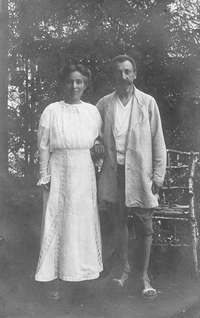
Weill's parents, Emma Ackermann and Albert Weill
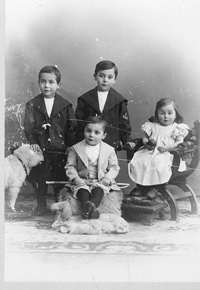
The four Weill children Hans, Nathan, Kurt (seated in front), and Ruth
Education
Weill got interested in making music at an early age and was supported by his family in his endeavours to learn music. He began piano lessons at the age of twelve and soon began to write songs, mostly to the verse of serious poets. He also received training in music theory, composition and conducting by the age of thirteen, his earliest preserved composition was written in 1913 and is titled Mi Addir. Jewish Wedding Song.
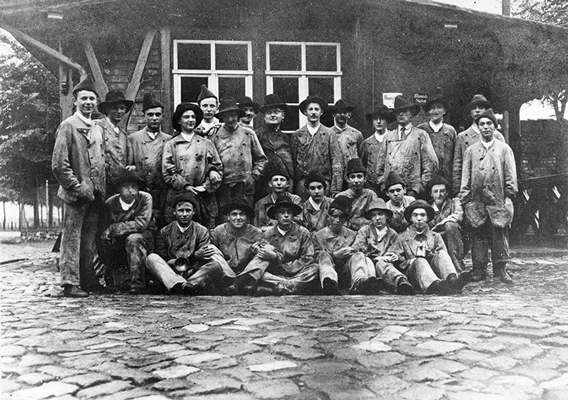
Class picture (ca. 1915); Weill is seated at the far right, first row
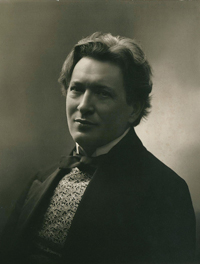
Ferruccio Busoni (April 1, 1866 –July 27, 1924) was an Italian composer, pianist, conductor, editor, writer, and teacher.
From 1914 to 1918, he took piano lessons from Albert Bing in Desau. By the time he was seventeen he was already helping to support the family with money earned as an accompanist. After enrolling in the Berlin Hochschule in 1918 to receive training from noted proponents of nineteenth century Romanticism Krasselt and Engelbert Humperdinck, Weill tired of formal teaching and left the school after only a year. He held a few musical directorship positions, then realized that he needed more training and returned to Berlin to study under the great Italian pianist and musical theorist Ferruccio Busoni. During these student years, Weill worked industriously on many purely instrumental works and songs, mostly in Post-Romantic style, as well as his first attempts at opera.
Musical career
Weill’s family faced a troubled financial situation following the aftermath of WW1. It compelled him to return back to Dessau and work to make his family lead a comfortable life. Weill began working at a local theatre as a répétiteur and later joined several other operas as a music composer and a Kapellmeister. Around the same time, he also began composing music. During this time, he composed an orchestral suite in E-flat major, a symphonic poem of Rainer Maria Rilke’s Die Weise von Liebe und Tod des Cornets Christoph Rilke (The Love and Death of Cornet Christopher Rilke) as well as Schilflieder (Reed Songs), a cycle of five songs to poems by Nikolaus Lenau. In December 1919, through the help of Humperdinck, Weill was appointed as Kapellmeister at the newly founded Stadttheater in Lüdenscheid, where he directed opera, operetta, and singspiel for five months, and also composed a cello sonata and Ninon de Lenclos, a now lost one-act operatic adaptation of a play by Ernst Hardt. Before he returned to Berlin, he composed Sulamith, a choral fantasy for soprano, female choir, and orchestra. When his family’s financial situation got a little better, Weill moved back to Berlin in 1920.

Weill (front row, left) with singers in costume from the Stadttheater Lüdenscheid
Post the First World War, the cultural and artistic environment of Berlin was thriving in the early 1920s. Soon after returning, ace composer Ferruccio Busoni took him in as a student. He was a part of the movement where several new artists emerged on the scene. As the distinctively chaotic culture of Berlin between the wars began to thrive, Weill found his way into the Novembergruppe, an organization of progressive artists from different disciplines that included musicians such as Hanns Eisler and Stefan Wolpe. In this progressive environment, Weill found collaborators who would help mold his innovative vision of modern music theater, including Yvan Goll and Georg Kaiser (whose assistant, Lotte Lenya, became Weill’s wife and a powerful force in his career).
In 1922, Weill composed a psalm, a divertimento for orchestra, and Sinfonia Sacra: Fantasia, Passacaglia, and Hymnus for Orchestra. On November 18, 1922, his children’s pantomime Die Zaubernacht (The Magic Night) premiered at the Theater am Kurfürstendamm; it was the first public performance of any of Weill’s works in the field of musical theatre. Soon thereafter, the Berlin Philharmonic performed his Divertimento for Orchestra and the Hindemith-Amar Quartet played his String Quartet Op. 8. In late 1923 Weill concluded his studies with Busoni and was well on his way to being seen as one of the leading composers of his generation.
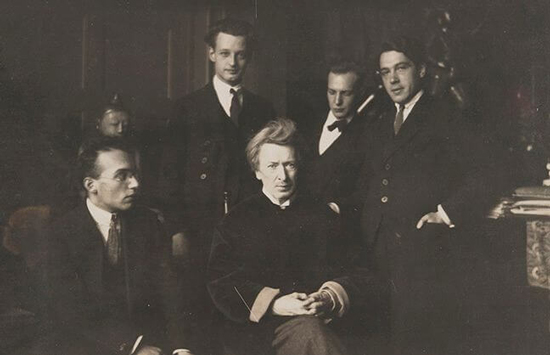
Ferruccio Busoni surrounded by his "disciples" from the master class. Kurt Weill, Walther Geiser, Luc Balmer, and Wladimir Vogel
In spite of his roots in the avant-garde, both his esthetic and his left-wing political convictions soon led Weill to feel that it was essential for his music to appeal to a broad general audience and he began to work primarily in the musical theater. In 1926, Weill’s first opera, Der Protagonist (The Protagonist), in one act, had a sensational debut in Dresden. Its librettist was Georg Kaiser, the most prominent playwright during the years of the Weimar Republic. Kaiser’s expressionist style avoided characterization and psychology, relying on archetypes to focus on society’s ills; his influence was strong upon the dramatists Iwan Goll and Bertolt Brecht, who would also work closely with Weill.
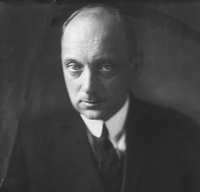
Georg Kaiser (November 25, 1878 – June 4, 1945) was a German playwright
His second opera, The Royal Palace, featured experimentation with various jazz forms, and he incorporated even more jazz into Der Zar lässt sich photographieren (The Czar Has Himself Photographed), which was very popular with German audiences. Some German critics, however, felt that this work was a sellout of his talent to accommodate the tastes of the masses.
Der Protagonist and Royal Palace established him as a promising young composer. His style was highly personal and his energy was admired by his contemporaries. In 1927 came another work with Georg Kaiser, Der Zar lässt sich photographieren (The Czar Has His Picture Taken). While working on the Der Zar lässt sich photographieren score, Weill became acquainted with Bertolt Brecht, an avant-garde German poet and dramatist.
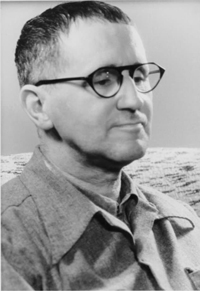
Berthold Brecht (February 10, 1898 – August 14,1956) was a German theatre practitioner, playwright, and poet
Weill’s best-known work is Die Dreigroschenoper (The Threepenny Opera), written in collaboration with Bertolt Brecht, was a reworking of John Gay’s The Beggar’s Opera (1728) with the 18th-century thieves, highwaymen, jailers, and their women turned into typical characters in the Berlin underworld of the 1920s. This work established both the topical opera and the reputations of the composer and librettist. Weill’s music for it was in turn harsh, mordant, jazzy, and hauntingly melancholy. Engel directed the original production of The Threepenny Opera in 1928. Within a year after its first staging, The Threepenny Opera was performed more than 4,200 times in the major capitals of Europe. Although it was a failure with critics in its American debut in 1933, a 1954 revival ran for six years and became one of the most successful musicals ever staged in the United States. Weill’s best-known song from the production was Die Moritat von Mackie Messer (Mack the Knife), which in 48 recorded versions sold over ten million copies. The song reached Number One on the Hit Parade in the United States in 1955. Collaborating with Brecht convinced Weill that he was through with traditional opera, and that musical theater was the one medium that allowed him to satisfy all his musical interests.
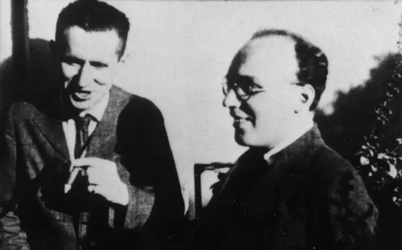
Bertolt Brecht and Kurt Weill in 1930
In March 1930 Brecht and Weill’s collaboration produced yet another successful opera titled Aufstieg und Fall der Stadt Mahagonny (Rise and Fall of City of Mahagonny), composed 1927-1929. Widely considered Weill’s masterpiece, the opera’s music showed a skillful synthesis of American popular music, ragtime, and jazz. However, around this time both Brecht and Weill began having disagreements over their political differences.
In the early 1930s, the growing right-wing in form of the Nazi Party was slowly beginning to impact his career. Weill initially misread the rise of the German right-wing and took it lightly.
Weill’s political and musical ideas and his Jewish birth made him persona non grata to the Nazis. When he came to know that he and his wife were on the Nazi blacklist and can be arrested, they decided to move somewhere else. Weill moved to Paris with his wife.
Brecht and Weill were brought together once more in Paris to create Die Sieben Todsünden (The Seven Deadly Sins; 1934). In the meantime, Weill collaborated with Caspar Neher on the opera Die Bürgschaft (The Pledge; 1931) and Georg Kaiser again on Der Silbersee: ein Wintermärchen (The Silver Lake: a Winter's Fairy Tale; 1933), works that garnered the hostile attention of the then-emerging Nazi party. With the rise to power of Hitler, Weill and Lenya were forced to dissolve their union and flee continental Europe.
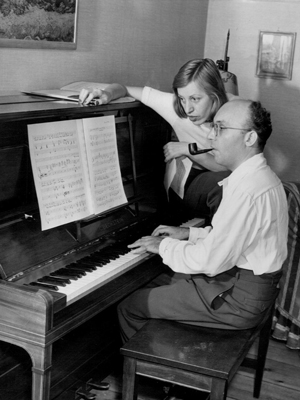
Kurt Weill and Lotte Lenya, his wife, in 1942
In 1935, Weill and his wife emigrated to the United States, where he began writing sophisticated musicals, the most notable being Johny Johnson (1936), Knickerbocker Holiday (1938; written with Maxwell Anderson), Lady in the Dark (1941), and One Touch of Venus (1943; written with Ogden Nash). In these works Weill employed with great facility advanced techniques, including multiple rhythms and polytonality, combined with the idiom of American popular music and jazz. His last works, in a more serious vein, included Street Scene (1947), Down in the Valley (1948), and Lost in the Stars (1949; written with Maxwell Anderson). His wife, the singer Lotte Lenya, played many of the leading roles in his works and was his defining interpreter. Weill also wrote some instrumental works; a cantata, Lindbergh’s Flight (1929); and The Eternal Road (1934), a pageant of Jewish history originally composed in German with text by Franz Werfel. Weill became a U.S. citizen in 1943.
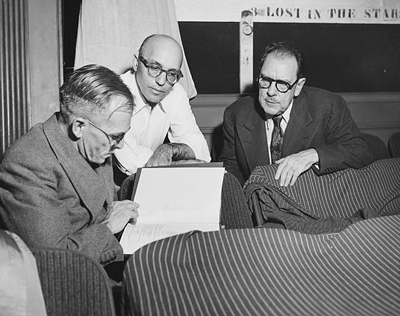
Author Alan Paton, composer Kurt Weill and playwright Maxwell Anderson, sitting together reading a script, circa 1950
Personal life and death
Through Kaiser, Weill met actress and singer Lotte Lenya in the summer of 1924. They would be married in 1926, divorced in 1933, and married again in the United States in 1937. Theirs was an “open” marriage that lasted until Weill’s death in 1950.
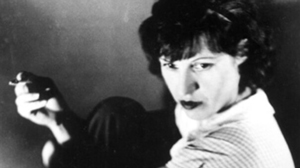
Lotte Lenya, Kurt Weill’s wife
On April 3, 1950, in New York City Weill unexpectedly suffered a massive coronary and died in Lenya’s arms. He was buried in Mount Repose Cemetery in Haverstraw, New York.
Weill’s estate was valued at less than 1,000 dollars, and Lenya realized that his contribution to musical theater was likewise undervalued. She commissioned composer Marc Blitzstein to adapt an English-language version of Die Dreigroschenoper; it opened off-Broadway in 1954 and ran for three years, touching off a Weill revival that continues. Lenya subsequently established the Kurt Weill Foundation for the management and promotion of his legacy.
SHEET MUSIC
You can find and download free scores of the composer:
0 Comments